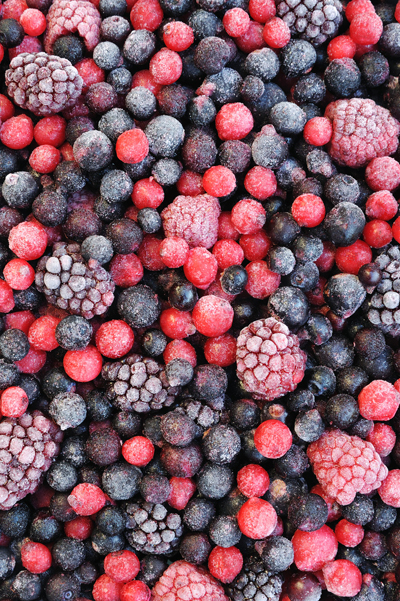Guide E-321
Revised by Nancy C. Flores and Cindy Schlenker Davies
College of Agricultural, Consumer and Environmental Sciences, New Mexico State University
Authors: Respectively, Extension Food Technology Specialist, Department of Extension Family and Consumer Sciences; and Program Director and Extension Home Economist, Bernalillo County Extension Office, New Mexico State University. (Print friendly PDF)
You can enjoy the taste of summer fruit during the fall and winter if you pick and freeze the fruit when it’s young and tender. Freezing is an economical, simple way to preserve large quantities of fruit.
Preparing Fruit for Freezing
Bacterial contamination can occur during fruit preparation. Clean all equipment and working surfaces before use. Wash hands thoroughly with soap and water before starting process.
Only prepare as much fruit as you can handle in a time period that doesn’t result in degradation of the fruit. Wash fruit thoroughly. Fill sink basin or deep container with cool tap water, and lightly scrub fruit with a brush to remove heavy soil and debris. Use a colander to lift fruit out of the water to prevent soil from being re-deposited. Many fruits are peeled before further processing by submerging fruit in boiling water for 30–45 seconds and cooling immediately in ice water. Skins should come off easily. Drain and towel dry. Cut fruit and remove pits or seeds. To prevent darkening, treat white and light-colored fruit (apples, pears, peaches, nectarines, apricots) by dipping in a solution of ascorbic acid. Available in powdered form and often mixed with sugar, ascorbic acid can be purchased from pharmacies and supermarkets along with other food preservation equipment and supplies. Various brands are available, and instructions for their use with various fruits are printed on the package. Unsweetened pineapple juice, citric acid, and lemon juice are also used as anti-darkening treatments, but they are less effective. Apples and rhubarb can be blanched for 2 minutes to prevent darkening.
Freezing Process
Oxidation (rancidity) can occur during freezer storage, causing off flavors when frozen product is exposured to air. Using high-quality plastic bags or containers designed for freezing can prevent rancid flavor development, as well as protect against freezer burn that is a result of moisture loss.
The process of freezing involves freezing the water in the cellular spaces of fruit tissue. As this water freezes, it expands and forms ice crystals that rupture cell walls, resulting in a softer texture once fruit is thawed. To reduce cellular damage, chill and freeze fruit quickly so that the ice crystals formed are smaller.
Packaged fruit should be frozen in a freezer set at -10°F for at least 24 hours before freezing large quantities of food. Freeze only the amount of food that can be frozen within a 24-hour period (2–3 lb per cubic foot of freezer space).
When freezing large quantities of food, packaged fruit should be chilled to less than 40°F in a refrigerator and then transferred to the freezer. This will speed up the freezing process and will maintain eating quality of the frozen fruit. Properly frozen and stored products should be used within one year. Label containers with food name and date processed.
Fruit to be used in cooked dishes (such as pies and sweetened spreads) and small berries may be tray frozen. Simply place the prepared fruit on a cookie sheet or tray lined with parchment paper and freeze until solid. Place frozen fruit into freezer containers, label, and date.
Overripe fruit may be frozen as a purée. Add ascorbic or citric acid to uncooked light-colored purées to preserve color. Use fruit purées as a topping on ice cream or other desserts.

(© Alena Brozova | Dreamstime.com)
Freezer Food Safety
Meat, poultry, fish, and eggs must be kept refrigerated at or below 40°F (4.5°C), and frozen food must be kept at or below 0°F (-18°C). If there is a power failure, maintain cold temperatures of the refrigerator and freezer by keeping doors closed as much as possible. A refrigerator will keep food safely cold for about 4 hours if it is unopened. A full freezer will hold the temperature longer than a half-full freezer for approximately 48 hours if the door remains closed. During a prolonged power outage, use dry ice or block ice. Fifty pounds of dry ice should maintain frozen temperatures for an 18-cubic foot full freezer for 2 days.
Home-prepared and commercially prepared frozen food that has partially thawed can be re-frozen if it contains ice crystals and feels as cold as refrigerated product. Frozen food that has thawed and been held above 40°F for over 2 hours (but less than 6 hours) can be re-frozen, but should be checked for mold, yeasty smell, or sliminess. Discard any questionable product, and do not re-freeze product that was allowed to thaw for more than 6 hours.
Sugar Pack
Sugar packing works well with juicy fruit such as peaches or cut strawberries since it discourages darkening. Mix prepared fruit with sugar and ascorbic acid. A good rule of thumb is 1/2 to 2/3 cup of sugar to each quart of prepared fruit. Gently stir until fruit is coated and sugar is dissolved. Pack fruit into freezer containers and freeze.
Syrup Pack
Syrup packing preserves fruit with the firmest texture, such as pears or apples. Prepare desired syrup (see Table 1) and chill completely in the refrigerator before preparing the fruit. If using freezer bags, support them in a bowl while filling. Spoon fruit into the container and cover with chilled syrup. Allow room for expansion: 3/4 inch below closure in pints, 1–2 inches or more in larger sizes. Remove air and seal. Fruit may also be packed in water, but it will be less firm when thawed.
|
Table 1. Freezer Syrups With Sugar and Honey |
|||
|
Syrup |
Water |
Sugar |
Honey* |
|
Light |
4 cups |
2 cups |
— |
|
3 cups |
— |
1 cup |
|
|
Medium |
4 cups |
3 cups |
— |
|
2 cups |
— |
2 cups |
|
|
Heavy |
4 cups |
4 ½ cups |
— |
|
*Honey is sometimes substituted for sugar because of its flavor, but it is not more nutritious. Honey should not be given to infants under one year of age as it may contain botulism spores, which are not destroyed in immature intestinal tracts. |
|||
Artificial Sweeteners
Artificial sweeteners like aspartame, saccharin, and sucralose work well when freezing fruit. However, they don’t prevent darkening or increase thickness of freezing syrups. Fruit sweetened with artificial sweeteners will freeze harder and thaw more slowly. Artificial sweeteners can be added to thawed fruit just before serving for added sweetness. Follow directions on the sweetener packaging for amounts needed when freezing fruit. Use frozen fruits treated with artificial sweeteners within 8–12 months for best taste.
Individually Quick Frozen (IQF)
Berries and other delicate fruits store better when individually quick frozen. Once frozen, fruit can be packaged and stored in a freezer. A major advantage of this process is that the fruit pieces do not clump, and individually frozen pieces can be removed without thawing the entire package. Individual fruit pieces can be frozen on trays covered with parchment paper placed in a freezer, or use the dry ice method below. Once frozen, the fruit pieces are easily removed from the trays and placed into freezer containers or bags.
Dry ice is available at many grocery stores and local ice-making facilities. Caution: Wear insulated mitts or gloves when handling dry ice since it will cause freezer burn upon contact with skin. To use dry ice for IQF, place fruit pieces into a large stainless steel bowl. While dry ice is in the package, break up the block with a hammer. Wearing insulated gloves, carefully un-wrap the dry ice and pour pieces into the bowl. Gently stir with a stainless steel spoon until fruit is evenly covered with dry ice. Cover the bowl loosely with a clean towel and place the bowl into a refrigerator. After 30 minutes, remove the bowl from refrigerator using insulated gloves or mitts. Using a stainless steel spoon, transfer frozen fruit into a labeled, sealable container. Store packaged IQF fruit promptly in the freezer.
Freezer Containers
Use containers specifically designed to store frozen food, such as freezer bags or freezer containers. Not all disposable or plastic containers are made for freezing (e.g., yogurt or cottage cheese containers). Choose containers that are moisture- and vapor-resistant; durable and leak-proof; resistant to oil, grease, or water; nonabsorbent of off flavors or odors; resistant to cracking at low temperatures; and easy to seal and mark with contents and date.
Suitable containers include wide-mouth glass jars that can be used for both freezing and canning foods. Tighten lids on glass jars after the product is frozen to prevent breakage due to inadequate headspace. Headspace in freezer containers allows for expansion of frozen food. Lids should fit securely or be sealed with freezer tape. Label contents with special instructions such as the amount of sugar or lemon juice used, the name of the fruit, and date of preservation. Use a freezer pen, which won’t run or fade when exposed to moisture. This information is especially important if fruit will be used in jams or other recipes later.
Thawing and Preparing Fruits to Eat
Growth of spoilage organisms can continue during freezer storage, especially when the freezing process is slow or when the temperature rises above 0°F.
Open package just before serving and serve while slightly frozen. Allow for any sugar added at freezing when using frozen fruit in cooked recipes. Freshly made jellies, jams, marmalades, and preserves from frozen berries are superior in flavor, color, and texture to those made from fresh berries since the juices are fully released by the freezing process.
Instructions for Freezing Fruits
Apples
Peel, core, and slice. Best if blanched 2 minutes, rinsed in ice water, drained, then sugar-packed or syrup-packed with medium syrup. For pies, place apple slices in boiling water for 2 minutes and cool in ice water. Make filling when defrosted using any recipe desired.
Applesauce
To each quart of apples add 1/3 cup water and 1/4 teaspoon ascorbic acid. Cook until tender, purée, and add 1/4 cup sugar per 4 cups hot purée. Stir until dissolved. Cool and pack into freezer containers.
Apricots
Not necessary to peel, but submerge fruit in boiling water for 30 seconds to keep peel from toughening. Remove pits and treat for discoloration. Dry pack or use medium syrup.
Bananas
Select firm, ripe bananas. Peel; mash or purée thoroughly. Add 1/2 teaspoon (1500 mg) ascorbic acid per cup of mashed banana or add 1/8 teaspoon ascorbic or citric acid or 1 tablespoon lemon juice per cup of mashed banana. Package, seal, and freeze.
Berries (except strawberries)Wash carefully in cool tap water. Drain. Dry pack, sugar pack, or freeze in medium syrup. Soft berries such as raspberries and blackberries freeze best in syrup. Use dry-packed berries while still partially frozen.
Cherries
Sour: Wash in cool tap water, stem, and pit. Mix one part sugar to four parts fruit or freeze in a heavy syrup.
Sweet: Wash, stem, and pit. Treat light-colored cherries, such as Royal Anne, with ascorbic acid to prevent darkening. Tray freeze sweet cherries.
Figs
Wash. Peel if desired. Use a light or medium syrup. Add either 1/2 cup lemon juice or 3/4 teaspoon ascorbic acid to one quart of freezer syrup for a better product. Pack figs into containers, cover with cold syrup, and freeze.
Grapes
Remove seeds. Dry pack or pack in a syrup made from 6 oz frozen lemonade concentrate mixed with 12 oz water.
Grape Juice
Heat grapes and then press or strain juice through a cloth bag. Sweeten to taste with sugar. Pour into container and freeze.
Mangos
Select firm, ripe mangos that yield to gentle pressure. Wash, peel, and slice. Several options are available to freeze mango products:
Syrup Pack—Pack slices in containers. Cover with a medium syrup. Leave headspace. Seal and freeze.
Unsweetened Tray Pack—Arrange slices on a flat pan and freeze. When frozen, remove and store in sealed containers.
Purée—Press mango slices through a sieve, blender chop, or chop in a food processor. Pack into containers with or without sugar. Leave headspace. Seal and freeze.
Melons
Remove seeds, peel, and cut melon into cubes or slices. Best packed in light syrup. Serve slightly frozen.
Peaches/Nectarines
Remove skins from peaches by submerging in boiling water for 30–45 seconds and cooling immediately in ice water. Skins should come off easily. Drain, remove pit, and slice. It is unnecessary to peel nectarines, but dip nectarines in boiling water for 30 seconds to prevent skin from toughening. Treat with ascorbic acid to prevent darkening. Can be dry frozen, but best in medium syrup. Serve slightly frozen.
Pears
Peel, core, and slice. Best if lightly cooked in boiling medium syrup for 1 minute. Cool before packing pears and syrup into freezer containers.
Pineapple
Peel, core, and slice or crush before packing. Juice will accumulate, even without sugar. May also be packed with light syrup. Serve slightly frozen.
Plums
Washed plums can be frozen without further preparation. Tray freeze, then dry pack. Serve slightly frozen. May also be sugar packed or frozen in medium syrup.
Pomegranates
Select completely ripe pomegranates. Wash, cut in half, and place cut side down. Break shell with a blunt instrument to open section walls and release juice. Pack juice and pulp into containers. Cover with cold light syrup (leaving headspace) and freeze.
Rhubarb
Wash, discard leaves, and cut stalks into 1-inch pieces. Treat with ascorbic acid to prevent darkening. May also be sugar packed or blanched 2 minutes and packed in medium syrup.
Strawberries
Gently wash berries in several changes of cool tap water and drain. Remove caps. May be sugar packed or packed in medium syrup. May also be tray frozen with no sugar. Purée very ripe strawberries. For each two cups of puréed fruit, add 1/4 cup sugar and 1 teaspoon lemon juice.
References
https://nchfp.uga.edu/how/gen_freeze.html
For further reading
E-311: Freezing Green Chile | Como congelar chile verde
https://pubs.nmsu.edu/_e/E311/
E-314: Make Jelly, Jam, and Spread at Home
https://pubs.nmsu.edu/_e/E314/
E-316: Home Canned Fruit Pie Fillings
https://pubs.nmsu.edu/_e/E316/
E-320: Freezing Vegetables
https://pubs.nmsu.edu/_e/E320/
|
Original authors: Alice Jane Hendley, Extension Specialist Emerita; and Martha Archuleta, Extension Food and Nutrition Specialist. |

Nancy Flores is the Extension Food Technology Specialist in the Department of Extension Family and Consumer Sciences at NMSU. She earned her B.S. at NMSU, M.S. at the University of Missouri, and Ph.D. at Kansas State. Her Extension activities focus on food safety, food processing, and food technology.

Cindy Schlenker Davies is the County Program Director and Extension Home Economist at NMSU’s Bernalillo County Extension Office. She earned her B.S. at Eastern New Mexico University and her M.A. at NMSU. Her Extension and public outreach work focuses on food processing and preservation and food safety.
To find more resources for your business, home, or family, visit the College of Agricultural, Consumer and Environmental Sciences on the World Wide Web at pubs.nmsu.edu
Contents of publications may be freely reproduced for educational purposes. All other rights reserved. For permission to use publications for other purposes, contact pubs@nmsu.edu or the authors listed on the publication.
New Mexico State University is an equal opportunity/affirmative action employer and educator. NMSU and the U.S. Department of Agriculture cooperating.
Revised November 2015


